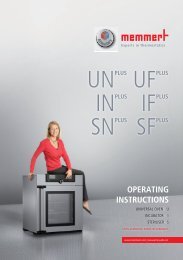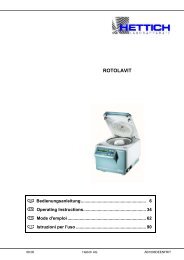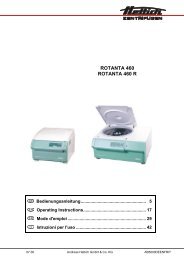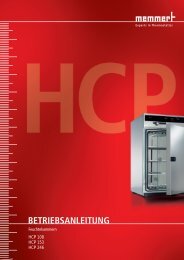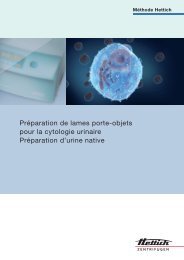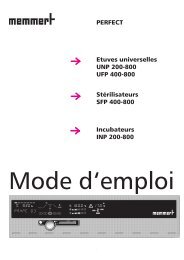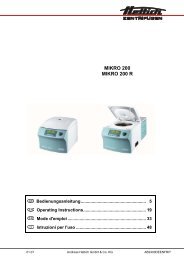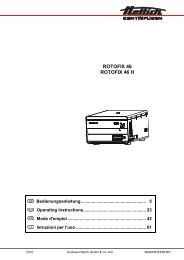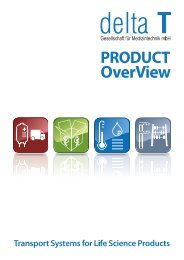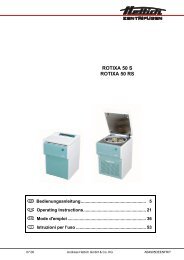MAN-Rotina380-e - Hettich AG, CH
MAN-Rotina380-e - Hettich AG, CH
MAN-Rotina380-e - Hettich AG, CH
Create successful ePaper yourself
Turn your PDF publications into a flip-book with our unique Google optimized e-Paper software.
EN<br />
4 Notes on safety<br />
No claim under guarantee will be considered by the manufacturer unless the above instructions have<br />
been adhered to.<br />
• Before the initial operation of your centrifuge you should read and pay attention to the operating<br />
instructions.<br />
Only personnel that has read and understood the operating instructions are allowed to operate the<br />
device.<br />
• Along with the operating instructions and the legal regulations on accident prevention, you should also follow the<br />
recognised professional regulations for working in a safe and professional manner.<br />
These operating instructions should be read in conjunction with any other instructions concerning accident<br />
prevention and environmental protection based on the national regulations of the country where the device is to<br />
be used.<br />
• This centrifuge is a state-of-the-art piece of equipment which is extremely safe to operate.<br />
−<br />
However, it can lead to danger for users or others if used by untrained staff, in an inappropriate way or for a<br />
purpose other than that it was designed for.<br />
• The centrifuge should be installed on a good, stable base.<br />
• Before using the centrifuge absolutely check the rotor for firm placement.<br />
• When the centrifuge is running, according to IEC 61010-2-020, no persons, dangerous substances or objects may<br />
be within the safety margin of 300 mm around the centrifuge.<br />
• The centrifuge must not be moved or knocked during operation.<br />
• In case of fault or emergency release, never touch the rotor before it has stopped turning.<br />
• To avoid damage due to condensate, when changing from a cold to a warm room the centrifuge must either heat<br />
up for at least 3 hours in the warm room before being connected to the mains, or run hot for 30 minutes in the<br />
cold room.<br />
• Only the rotors and accessories approved by the manufacturer for this device may be used (see chapter<br />
"Anhang/Appendix, Rotoren und Zubehör/Rotors and accessories").<br />
• The centrifuge rotor may only be loaded in accordance with the chapter "Loading the rotor".<br />
• When centrifuging with maxim revolutions per minute the density of the materials or the material mixtures may not<br />
exceed 1.2 kg/dm 3 .<br />
• The centrifuge may only be operated when the balance is within the bounds of acceptability.<br />
• The centrifuge may not be operated in explosion-endangered areas.<br />
• The centrifuge must not be used with:<br />
− inflammable or explosive materials<br />
− materials that react with one another producing a lot of energy.<br />
• If users have to centrifuge hazardous materials or compounds contaminated with toxic, radioactive or pathogenic<br />
micro-organisms, they must take appropriate measures.<br />
For hazardous substances centrifuge containers with special screw caps must strictly be used. In addition to the<br />
screw cap centrifuge containers, for materials in hazard category 3 and 4 a biosafety system must be used (see<br />
the World Health Organisation’s “Laboratory Biosafety Manual”).<br />
In a biosafety system, droplets and aerosols are prevented from escaping by a bioseal (packing ring).<br />
If the hanger of a biosafety system is used without the lid, the packing ring must be removed from the hanger in<br />
order to prevent the packing ring from being damaged during the centrifugation run. Damaged packing rings must<br />
not be used to seal the biosafety system.<br />
Without the use of a biosafety system the centrifuge is not microbiologically sealed in the sense of the EN<br />
610101-2-020 standard.<br />
For further details of available biosafety systems see chapter "Anhang/Appendix, Rotoren und Zubehör/Rotors<br />
and accessories". If in doubt, you should obtain relevant information from the manufacturer.<br />
• The centrifuge must not be operated with highly corrosive substances which could impair the mechanical integrity<br />
of rotors, hangers and accessories.<br />
• Rotors, suspensions and accessories that possess traces of corrosion or mechanical damage or if their term of<br />
use has expired may not be used any longer.<br />
• Repairs must only be carried out by personnel authorised to do so by the manufacturer.<br />
• Only original spare parts and original accessories licensed by the Andreas <strong>Hettich</strong> GmbH & Co. KG company are<br />
allowed to be utilised.<br />
• The following safety regulations apply:<br />
IEC 61010-1 and IEC 61010-2-020 as well as their national deviations.<br />
• The safe operation and reliability of the centrifuge can only be guaranteed if:<br />
−<br />
−<br />
−<br />
the centrifuge is operated in accordance with the operating instructions,<br />
the electrical installation on the site where the centrifuge is installed conforms to the demands of IEC<br />
stipulations,<br />
prescribed tests to BGV A1, BGR 261 are carried out by an expert.<br />
26/105



